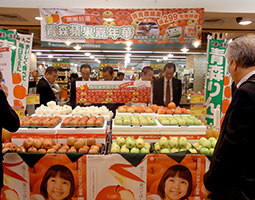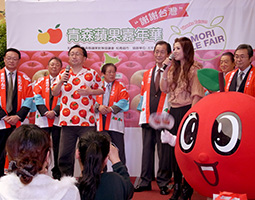Home > Highlighting JAPAN > Highlighting Japan November 2016 > The World of Japanese Cuisine
Highlighting JAPAN


Open Orchards
The apple farmers of Aomori Prefecture are extending their branches to markets in Asia.
Aomori Prefecture, located in the northernmost part of Honshu, is the largest producer of apples in Japan. Apple cultivation began here after the Meiji Restoration of 1868, when many formerly privileged samurai sank into poverty. The new government encouraged the introduction of apple cultivation to create employment in the prefecture.
The weather is cool in Aomori even in the summer, making it a perfect place to grow apple trees, which are vulnerable to heat. The large temperature differentials throughout the day also help foster the growth of sweet, delicious fruit. Meanwhile the slow and steady efforts of farmers to increase orchard acreage and the push for varietal improvements have boosted the prefecture’s apple production. Last year the prefecture produced 470,000 tons of apples, nearly 60% of the entire domestic production.
The best known variety of apples grown in Aomori is Fuji, which was developed in the 1960s. Fuji apples are juicy, sweet and fragrant, and can also be stored for a long time. The prefecture produces about fifty varieties of apples with Fuji apples making up about half of that production.
In recent years, the apples grown in Aomori have become increasingly popular abroad, though export from the prefecture actually began as early as 1899.
“Japanese people were not in the habit of eating apples before the fruit started to be cultivated. At that time, the fruit was hardly sold at all in Aomori,” says Mamoru Fukasawa of the Aomori Prefecture Apples Export Association. “The merchants who bought apples from the farmers traveled to domestic locations where there were foreign settlements, such as Hakodate and Yokohama, and even to Russia and China to sell the fruits.”
Exports continued but were unstable owing to such factors as war, poor harvests and price declines. Apple exports hovered at around 2,000 tons every year in the 1990s, but shot up in 2002 when Taiwan joined the World Trade Organization (WTO) and lifted its restrictions on apple imports from Japan.
The Taiwanese give apples as gifts at Chinese New Year and dedicate the fruit to their Buddhist deities. The Taiwanese cultivate tropical fruits such as bananas, papayas and mangoes, but apples are difficult to grow in the country due to its hot and humid climate and they make up Taiwan’s largest imports of fruit.
“Because Taiwanese consider red to be a happy and auspicious color, the vividly red apples of Aomori are very popular in Taiwan,” says Fukasawa. “During the period when there were restrictions imposed on imports, many of the apples that Aomori exported to Taiwan were large-sized fruits with high prices. This explains why Taiwanese associate the apples grown in Aomori with luxury items and continue to treat them as gifts even today.”
In 2015, Japanese apple exports hit an all-time high of 36,304 tons with apples produced in Aomori accounting for more than 90% of the total. Of the seventeen apple importers, Taiwan’s imports were the largest at 27,301 tons. In recent years, there has been an increase in Taiwan’s imports of reasonably priced small- and medium-sized varieties such as Fuji and Orin, as well as the expensive, large-sized varieties typically given as gifts, such as Sekai-ichi and Mutsu.
The Aomori Prefecture Apples Export Association has carried out a wide range of initiatives to increase the popularity of apples in Taiwan. One measure is the establishment of the Taiwan-Aomori Apple Friendship Society with Taiwanese traders and brokers. The Society invites about ten Taiwanese representatives to Aomori once a year for an exchange of information and a fact-finding tour of production sites, and carries out campaigns for apples produced in Aomori in the stores in many parts of Taiwan. Thanks to its cooperative efforts with Taiwan, in recent years Aomori has enjoyed a significant increase in apple exports to Hong Kong, China and Southeast Asian countries through overseas Chinese networks by way of Taiwanese traders.
“Aomori Prefecture has set the goal of increasing its apple exports to 40,000 tons by 2018. Fortunately, we have had no major natural disasters so far this year and have succeeded in growing a rich crop of high-quality, sweet and delicious apples,” says Fukasawa. “We sincerely hope that more people from Asia, including Taiwan, will enjoy eating apples produced in Aomori than ever before.”
© 2009 Cabinet Office, Government of Japan








